November 12 - 18, 2023: Issue 605
Chaplain Robert (Bob) Durbin
President Of War Vets Sub-Branch Narrabeen

Photo: Bob with Her Excellency the Honourable Margaret Beazley AC KC, Governor of New South Wales, RSL NSW Annual State Congress 2023 © Salty Dingo
On 22-24 October, delegates from the Northern Beaches District Council (NBDC) attended the RSL NSW State Congress in Newcastle. Four Local members received some prestigious awards;-
1. Bob Durbin President of War Vets sub-Branch Narrabeen was awarded the Meritorious Service Medal. There were only two people in the whole of NSW who received this award at Congress.
2. Deborah Carter President of Pittwater sub-Branch and Vice President of NBDC was awarded Life Membership of the League. (only 10 awarded)
3. Mrs Pamela Hansen Hon. Secretary Harbord RSL sub-Branch was awarded a Civilian Merit Medal.
4. Forestville Auxiliary were the 2nd best in NSW.
The Citation for Mr Durbin reads:
The Meritorious Service Medal is the highest honour which can be bestowed upon a Service Member of the RSL. All recipients must have at least 30 years continuous RSL membership, and given at least 25 years outstanding service to the League.
The first Meritorious Service Medal is presented to Mr Robert Durbin from the War Veterans Village (Narrabeen) RSL sub-Branch.
Mr Durbin served in the Royal Australian Navy for 20 years after enlisting in 1970. After discharge from the Navy, he joined the City of Blacktown RSL sub-Branch in 1990, were he remained a member for 27 years. During this time he held various positions including pensions officer, secretary, welfare officer, chaplain, president and far western metropolitan district council secretary, welfare officer and pensions officer. Mr Durbin also served at secretary of the City of Parramatta RSL sub-Branch from 2000 to 2010.
In 1996, Mr Durbin became the Operations Manager at ANZAC House, a position he held until 2000. He then went on to be a State Councillor at RSL NSW for 14 years, where he was also the RSL Corps of Guards Chaplain during this time.
Now a member of the War Veterans Village (Narrabeen) RSL sub-Branch, Mr Durbin has been the President since transferring in 2017 and is also one of two chaplains at this sub-Branch. It is estimated Mr Durbin has delivered over 800 tributes at funerals during his time as a member of the League.
Mr Durbin has always had a passion for the motto of “Mates Helping Mates” and would ensure not only were his tributes delivered within the RSL protocol but also by honouring the wishes of the family. Such is his commitment to delivering funeral tributes, he started offering RSL funeral workshops for other sub-Branches, something he continues to do.
Mr Durbin also serves as Chaplain to the Guardians of the Korean War Memorial New South Wales, HMAS Sydney Association, Tingira Australian Association and the Friends and Family of the First AIF Association.
Not only has Mr Durbin been instrumental delivering local commemorations during his time as a secretary of the City of Parramatta RSL sub-Branch, he has also been involved in other local community events including Australia Day.
In 2006, Mr Durbin was awarded Life Membership of the League and received an Australia Day Medallion in 2008.
This week, the day after Remembrance Day 2023, Chaplain Durbin shares some insights into his work and career.
Congratulations on being awarded the RSL NSW Meritorious Service Medal. What was it like to receive this recognition?
On various levels it was very humbling and I’m very honoured. I think, as people, we like to get pats on the back but this is an incredible pat on the back from your peers.
The Meritorious Service Medal is the highest honour which can be bestowed upon a Service Member of the RSL at a national level – it’s for 30 years of membership and a minimum of 25 years outstanding honorary service.
Back in 1990 when I joined the League I didn’t have sights set on Certificates of Appreciation or Life Membership and certainly not a Meritorious Service Medal; I had no idea what it was. I guess it’s something that, in the end, evolves, simply because I maintained, first of all, my membership, but secondly my active involvement in the Aims and Objects of the League and that is simply mates helping mates.
What areas have you worked in?
Apart from being a Trustee, I’ve pretty much held most positions in the RSL. I started out as a Pensions Officer, then I was a Delegate to the District Council, as part of that I was then Delegate to the RSL Sports Council – I wasn’t playing sports, I just became the Delegate. I became the Welfare Officer, I became the Secretary to two sub-Branches, I’ve been the President of two sub-Branches, City of Blacktown and here at the Narrabeen War Veterans. I was a State Councillor of the RSL for 14 years, and as a State Councillor I held many positions on State Council committees. I was the Chair of the RSL Youth Council for many years, I was on the St Mary’s Memorial Trust, and others. But really, I think it’s right to say I’ve fallen into those positions in some ways; I think I was perhaps in the right place at the right time to use the skills and gifts that I’ve been given.
What is the RSL Youth Council?
Around NSW many sub-Branches have Youth Clubs. The Youth Council is the co-ordinating body and they participate in a range of activities; trampolining, different types of dancing, you name the sport the RSL Youth Clubs have been involved in it at one stage or another.
Is it for children of RSL Members or for the community?
It’s normally opened up to members of the community. It started out as for children of Veterans but that has changed over the years and it’s been opened up for all communities. What it really does is make available to these young people the RSL ethos and ethics. They have their own Oath of Allegiance they recite at the beginning of each activity. Through this they learn about the Veteran family. We often talk about Veterans, and we look at people who march on Anzac Day and those who have their shirt full of medals, but the Veteran family is so much bigger than that. That’s what the RSL looks after – the Veteran family. That will be partners, husbands, wives of serving members, and the children of serving members, and by extension to a degree, the communities that they are involved in, so that they can be supported as well.
It's not all about securing pensions for those people who have a service-related disease, injury or illness – it’s about ‘what can we do for the family?’ – what can we do for these people who have been caring for Veterans. You look at the term ‘Veteran’ and it’s broadened in the last 10 years or so. Originally this was someone who has returned from active service, but when you look at what has happened to Defence, and you can go back further, but to go back to the HMAS Voyager disaster, where we lost 80 sailors at sea when HMAS Melbourne sliced through the middle of her, that this was a tragedy was an understatement, that loss of life. But again, you think about those who survived and the impact it would have had on them, but you also think of the families of those who did not survive; the mums, the dads, the partners, the brothers, sisters and children. We have had the Black Hawk disaster recently, you think of HMAS Westralia; we lost a couple of sailors, HMAS Stalwart, and that’s just Navy.
When you think of the other accidents, again the Black Hawk disaster – we’ve lost a lot of Servicemen and Servicewomen through training incidents.
We don’t always talk about them and for me, that’s what Remembrance Day is really about – it’s not just about going back to the end of World War One, it’s what has happened since then.
We have that Commemoration Service and we say at the end of the Ode ‘We Will Remember Them’ and ‘Lest We Forget’. We have inherited an incredible legacy from our founding fathers and we need to pick up that baton and continue to carry it forward and hand it on to those who are following us.
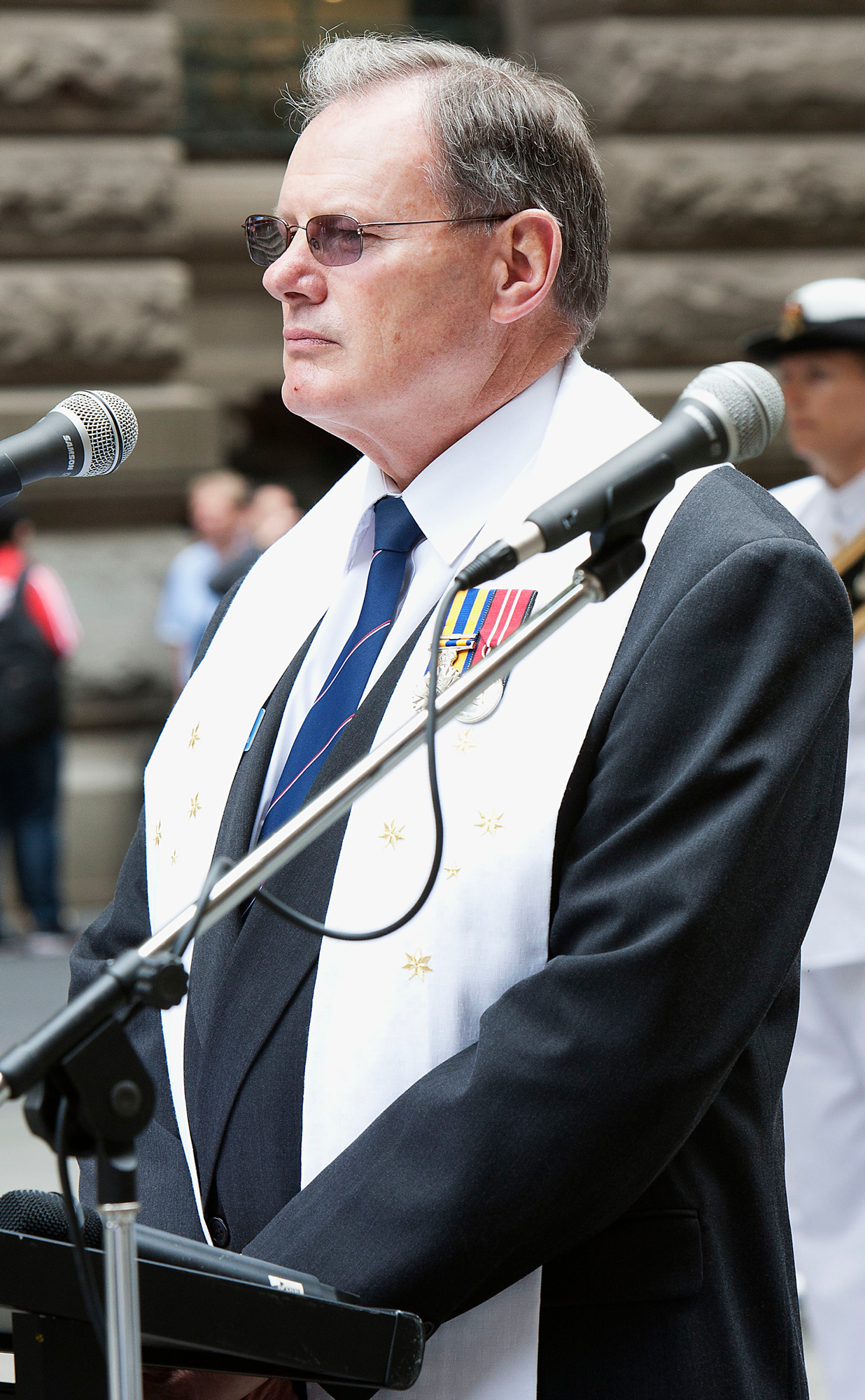
Photo: Chaplain Bob Durbin acting as the Master of Ceremony for the HMAS Sydney II Wreath Laying Ceremony at Martin Place, Sydney. File Date: 2012-11-19, courtesy Royal Australian Navy (RAN).
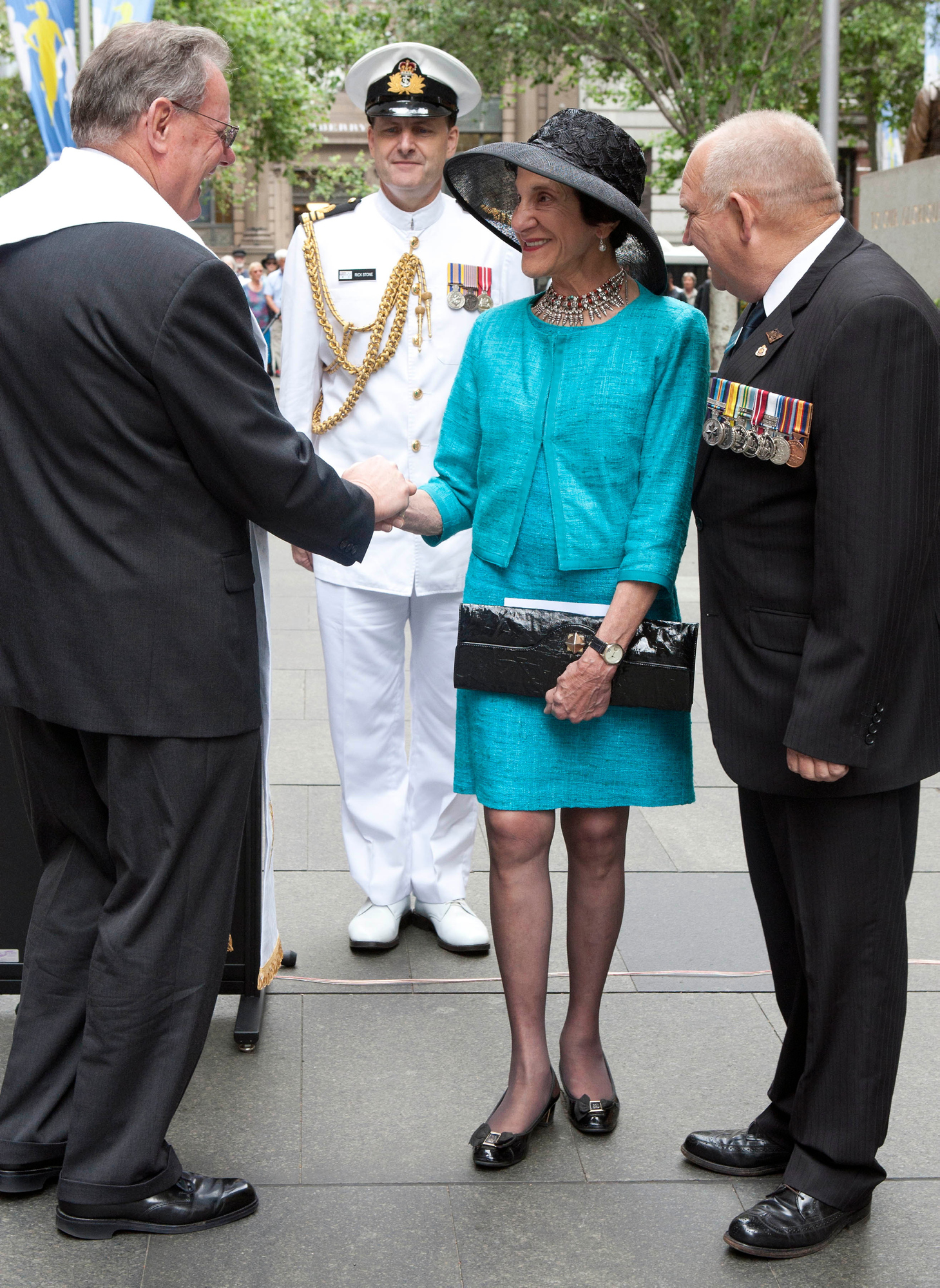
Photo: Her Excellency Professor Marie Bashir, AC CVO farewelling Chaplain Bob Durbin, Master of Ceremony on departure of the HMAS Sydney II Wreath Laying Ceremony at Martin Place, Sydney. November 19, 2012, courtesy Royal Australian Navy (RAN).
For the past thirty six years the HMAS Sydney association has held an annual Memorial Service and Wreath Laying Ceremony at the Cenotaph, Martin Place, Sydney to commemorate the sinking of HMAS Sydney II and the loss of her 645 crew on November 19, 1941. The 2012 HMAS Sydney II Wreath Laying Ceremony marked the 71st Anniversary.
Wreath Laying guests includes representatives from all Government levels, Ex Service Organisations, War Widows and Veteran organisations, Civil Authority and Department of Veteran Affairs. Personnel from the Royal Australian Navy Command Ceremonial and the Sydney Band Detachment of the Royal Australian Navy , the Cenotaph and Flag Party will be provided by local Naval Establishments. More importantly, also in attendance were Naval veterans from all wars and Conflicts since and including World War II, including a number of association members who served in HMAS Sydney II prior to its sinking. Finally a large number of family members of those 645 crewman lost on 19 November 1941 when HMAS Sydney II was sunk without survivors also attend to lay wreath.
When did you commence being the President of the War Vets sub-Branch Narrabeen?
It was 2017.
What is your role there as this is within an RSL Veterans Village?
I’m one of two full-time Chaplains here at the village. We provide spiritual care for our independent living residents and our residential care residents. We conduct a weekly ecumenical service in our chapel – we have a beautiful chapel here, which has a lot of military history in it. We also conduct services each week in our care homes.
That’s a fair amount of work each week?
There is a bit on each week – we also have Bible studies, we go and visit people, and we do funerals, regrettably. I shouldn’t say regrettably – funerals are something which are a privilege to conduct, and I also conduct the RSL Funeral Tribute for Veterans here in the Village. That is where we continue to Honour their Service.
What, for you, has been the most positive aspect of undertaking this work?
Simply assisting people, particularly when I was doing specific Pensions and Welfare work. In providing services that people weren’t aware of – they weren’t aware that there was an entitlement or an eligibility there to support them. Particularly, when I go back 15 or 20 years, and you look at a lot of these dear old WWII Veterans and their wives, or husbands as the case may be, and I’d think ‘mate, why are you still mowing your lawn? How long does it take you?’ – ‘oh, I’ll do a little bit today and a little bit tomorrow.’ to which I could say, ‘we can get you some help’.
It changes their lives, it changes their lifestyle. They’re freed up from doing those, in some ways, onerous and sometimes physically demanding things and it gives them a better quality of life.
For me, that’s our role. The Aims and Objects of the League to be there For and With the Veteran family, and if we can make their quality of life better then we are part way towards achieving what we’re meant to be doing.
What’s offered to support Veterans has expanded in recent years to incorporate addressing mental health – have you had any contact with utilising that for the benefit of Veteran members? There is a new Wellbeing Veterans Hub that has started up at Dee Why recently through RSL LifeCare…
Yes, over the years, and this is where it is regrettable, it has been necessary for us to direct people to places like St John of God. So many have a substance abuse problem and for different reasons for their Service, some may have turned, regrettably, to alcohol, in more recent years they’ve turned to drugs of addiction of different kinds. There it’s about being with them, not standing in front of them saying ‘mate, you have got this problem what are you going to do’ but standing with them, standing by them, and saying, ‘mate, you know you have got a problem, how can we help you?’. It’s all about how you do things – you stand with them and say ‘let me journey with you, and mate if we’re going to overcome this, we can’t do it ourselves, let’s find out who can.’. Then you can find the specialists for each individual need, refer them to the counsellors who will also take part in the journey, the whole of it, with them.
We actually have a lovely counsellor here in the Village who goes around and assists some of our Veterans. Each Veteran may have different issues for different reasons and it has a different effect. Our Homes for Heroes program for disadvantaged contemporary Veterans aims to address one identified need. These may be socially isolated, they may have lost their families because of how their Service has affected them and that follow-on affect to their families. So they need a safe place, and we are providing that safe place here.
Where did it all start – how did you become a Chaplain?
I have called myself ‘the accidental Chaplain’. I had no plan of doing this. When I left the Navy my wife and I got back into a more complete church life, if you like. During my Naval career, floating around, it was part time. I became a lay preacher of the Uniting Church. I’d been asked a few times ‘would you go into full-time ministry?’ and I said ‘no, that’s not me.’
Then in 2009 my Minister at the time said, ‘we need to have a discussion’. When a Minister says that you know you’re either in the good books or ‘what have I done wrong?’ – and I’m thinking, immediately, ’what have I done wrong?’.
At any rate, he said ‘I’d like you to consider becoming a full-time pastor’ – he obviously saw things in me that at the time I obviously didn’t see in myself. My wife was an absolute encouragement for me, and as they say, ‘the rest is history’. I did all the necessary training to go from being a lay-preacher to being a Pastor of the Uniting Church. Then when I received the approval from the Synod, the head body, I commenced.
When did you move to the Narrabeen RSL ANZAC Village?
We came here in 2010 and so am into my 14th year here. It is a privilege and a blessing to be here with these incredible people, notwithstanding the general community we have here but also the Veteran community, the Veteran family here.
What was the journey to Narrabeen – how did that occur?
Back in the early 2000’s, when I was a State Councillor with the RSL I was on the board of Directors here. I knew the CEO and he’d asked me to do some Ministry over at Rowland Village at Galston – he’d asked me to do some Bible studies and Services over there. Then I had a heart attack so that all fell by-the-bye.
When I was doing one of my final assessments I had to go to a psychologist and had to attend an appointment at Newport for this. So I rang Ron and told him I’d be over his way next Friday and thought I might drop in and have a cuppa with him. So we had a chat and he asked ‘what are you doing’ and I told him, and at that time I was assessing what my options were and where my full-time Ministry might be.
Less than a week later he sent me an email which said ‘if I create another position at the War Vets for a Chaplain, will you come?’. We had one full-time chaplain here but the tasking here is too big for one person, they needed two. I mulled it over for a while until my wife said to me ‘what are you procrastinating for? With all of your RSL involvement, and your Veteran background, and now your Ministerial background, aren’t you the right fit?’. I answered; well, I can’t argue with logic like that. So I got back in touch and said I’d be honoured to come over and I started in September of 2010.
You served in the Navy?
I served in the Royal Australian Navy for 20 years the first time around.
First time around?! How old were you the ‘first time around’?
I enlisted as a 16-and-a-half-year-old. I went to HMAS Nirimba, which was the apprentice training establishment at the time, back when apprenticeships were 5 years. I qualified as an Electrical Fitter Mechanic and have a few sub-specialisations within my trade as well. I served for 20 years and retired at the rank of Warrant Officer.
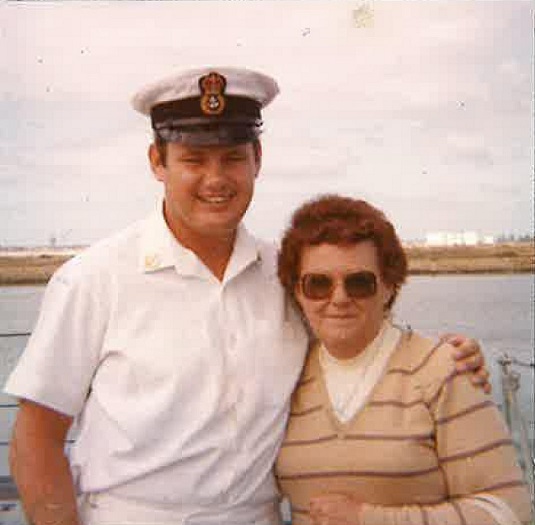
Bob with his mum
I transferred to the Naval Reserve and did a couple of years pretty much full-time work at Fleet Staff. Somewhere in the middle of that there was a hole for a full-time position and they explained that they couldn’t leave that position vacant, it must be filled and the Officer in charge of that particular team came around and said to me ‘how would you like to reenlist for 6 and a half months?’. I said ‘doing what?’, he said, ‘sitting in that chair’ because I was already filling in for the guy who had been promoted out of the job. So I said ‘awesome’ and in fact it was one of those jobs that I’d always wanted when I was initially in but it never fell to me. So that was wonderful and I did that for six and a half months and then went back into the Fleet Staff system and worked there resourcing the fleet through Reserves. Then when I turned 65 they said ‘you’re too old, see you later.’
I hadn’t been doing anything for a while by then – and they did say if you don’t have any work then there isn’t a position and that will be the end of it. I was already here doing full-time work so it was ok by me. I really couldn’t see myself going somewhere for a month at a time and doing what I was doing here effectively.
What are your favourite places in Pittwater and why?
The café at Warriewood beach in the surf club is my favourite. That’s a wonderful place to go – it’s idyllic to sit there and have a breakfast or a coffee. A couple of years ago I took my daughter down and we were watching the whales at play.
And walking around the lake of course; you can’t beat walking around the lake here at Narrabeen. It takes a while, it’s an 8 and a bit kilometre walk but it’s just beautiful and so different in its different places and throughout the seasons.

Bob with daughter Kim, ANZAC Day
What is your ‘motto for life’ or a favourite phrase that you try to live by?
Something that I often say, I don’t know that it’s my motto, but what I often say is
Work with what you have and make what you have work.
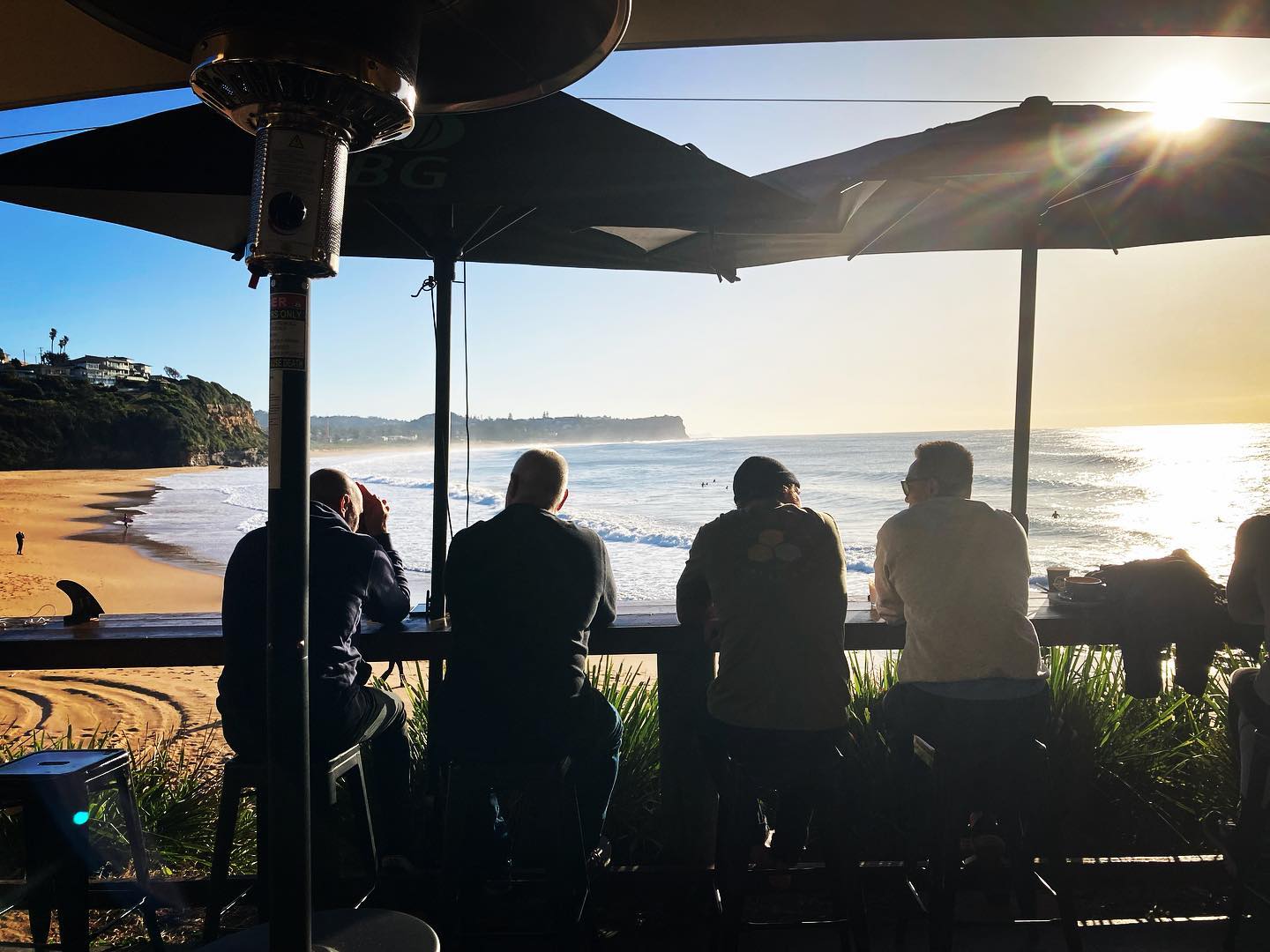
Breakfast at Warriewood Surf Club Cafe in 2023: Nice View!! Photo by Peter Salter
HMAS Nirimba
HMAS Nirimba is a former Royal Australian Navy (RAN) training base located at the former RAAF Station Schofields at Nirimba Fields, previously Schofields, in Sydney, New South Wales. Nirimba is a Darug word meaning pelican.
Schofields aerodrome was evaluated for use as the site of the RAN Aircraft Repair Yard, following the formation of the Royal Australian Navy Fleet Air Arm in November 1950. The RAN moved in and Schofields was temporarily commissioned as HMAS Albatross II, RANARY Schofields with a contingent of Royal Navy officers and sailors supplementing the RAN Component. In January 1952, the Royal Australian Air Force transferred control of the base to the RAN, but remained in residence until September 1952.
On 1 April 1953, the Royal Australian Naval Air Repair Yard Schofields was commissioned as HMAS Nirimba, a joint RANARY and technical training establishment for RAN Fleet Air Arm. The Aircraft Repair Yard was short lived however, and was closed down in early 1955 and HMAS Nirimba and the airfield were reduced to "Care and Maintenance" status.
In September 1955, preparations began to recommission HMAS Nirimba as the RAN Apprentice Training Establishment (RANATE) for Naval Apprentice training. The establishment reopened in January 1956, Captain F L George RAN assumed command. On 4 January 1956, HMAS Nirimba was paid off to recommission the next day as HMAS Nirimba, RAN Apprentice Training Establishment.
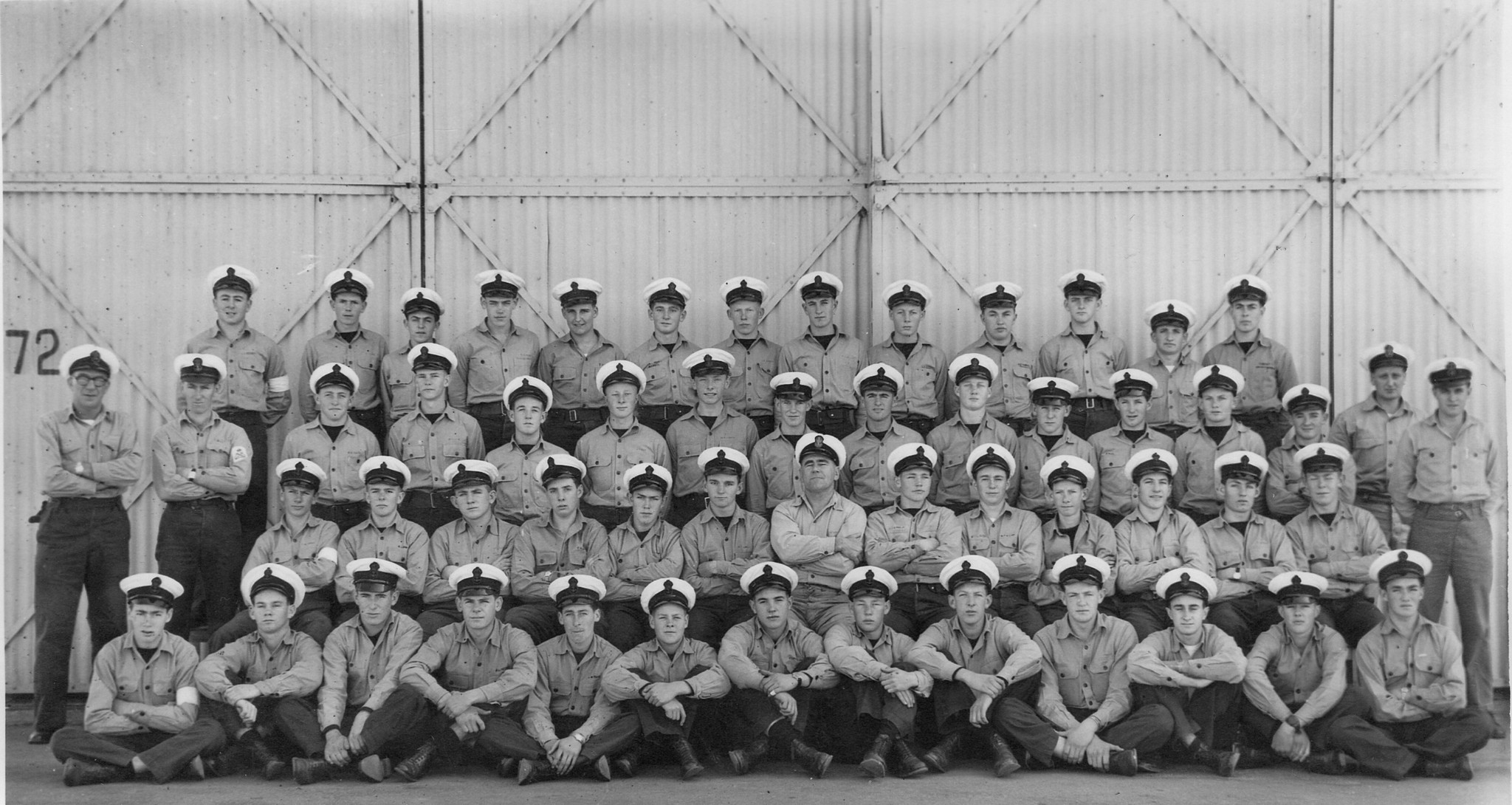
Group photo of cadet apprentices on 1 July 1956 at HMAS Nirimba, Quaker's Hill. Names are unknown. HMAS Nirimba is a former Royal Australian Navy training base located at the former RAAF station at Schofields. In 1956 it was recommissioned as HMAS Nirimba, RAN Apprentice Training Establishment. It was closed in 1994 and redeveloped as the Nirimba Education Precinct. This work is licensed under a Creative Commons Attribution-Noncommercial-Share Alike 3.0 New Zealand License. Image courtesy 'Blacktown Memories', Blacktown City Council Libraries
Nirimba was finally decommissioned on 25 February 1994, having trained some 13,000 young men and women from the RAN and other Commonwealth navies.
The site has since been redeveloped as the Nirimba Education precinct and houses facilities for the Western Sydney University, the Western Sydney Institute, Wyndham College and the St John Paul II Catholic College. In November 2020, the portion of Schofields that houses the precinct became the new suburb of Nirimba Fields.
The site also the scene of dress rehearsals for the 2000 Olympic Games opening ceremony.
From: "Background of the R.A.A.F. / R.A.N. at Schofields". HMS Nabthorpe. Archived from the original on 21 October 2012.
Further reading:
- Royal Australian Navy Fleet Air Arm
- Royal Australian Air Force Museum